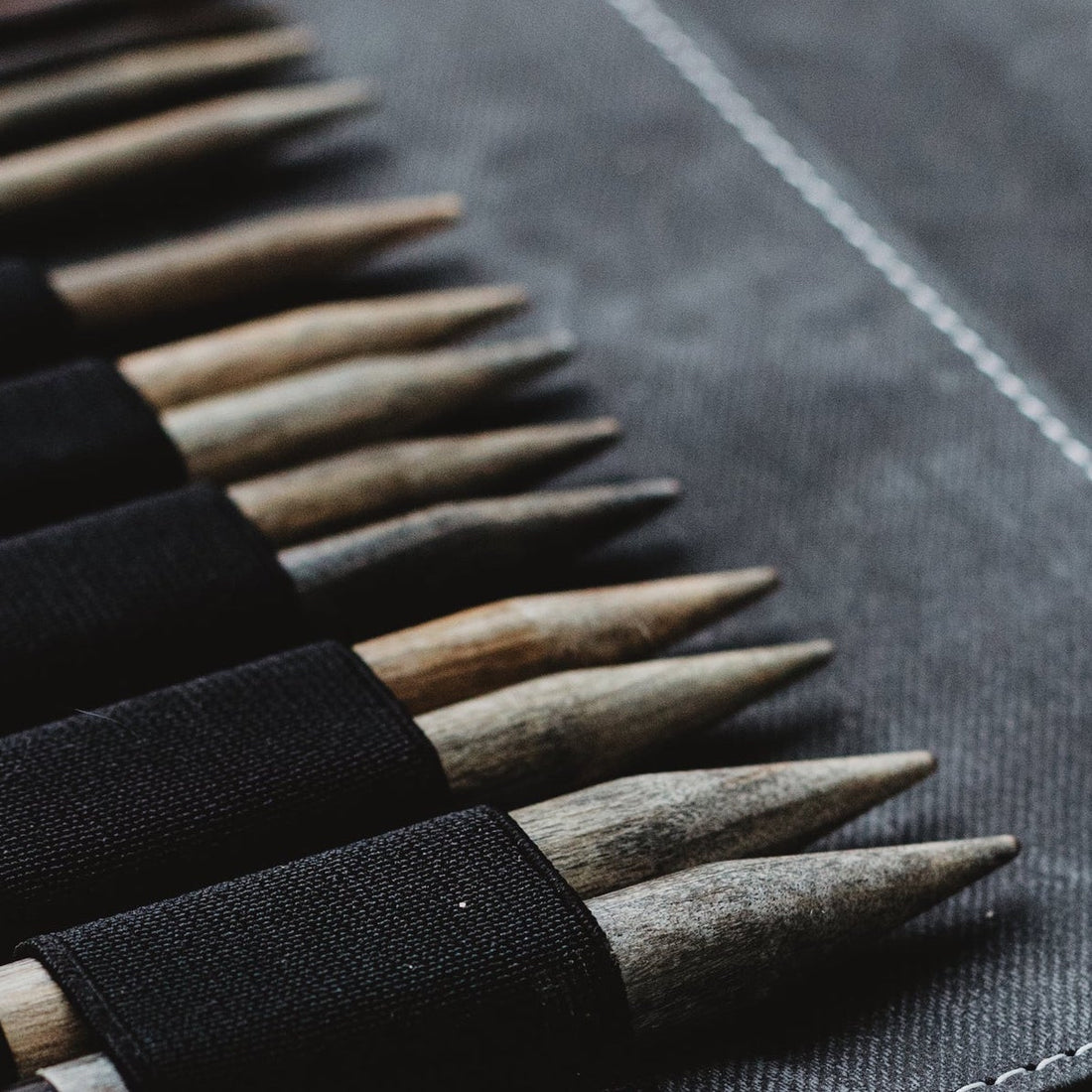To knit socks, you need to be able to knit in the round. In theory, they could be knit flat and sewn, but this would create a seam that would wear and possibly cause blisters...quite the opposite of what we want when we make a cozy treat for our toes!
There are a few different, and equally innovative methods for knitting in the round. All will get the same result -- a tube of knitting -- but if you ask knitters, you'll find proponents of every technique. When it comes down to it, the right technique is the one that you are personally most comfortable using. This is meant as a guide for those who haven't worked on socks before and want to understand what their options are, or for those who want to branch out and try a technique they perhaps haven't had the chance to yet:
Using Double Pointed Needles
This is the most traditional method for knitting in the round. Essentially, three (or five) needles hold the knitted tube in a closed square or triangle, and the knitter holds the fourth (or fifth) needle in their right hand to work with. As soon as all the stitches from one of the left hand needles are knitted onto the working needle in the right, you switch to the next needle in the triangle with your left hand, and the now-empty needle goes into the right. And repeat!
The most significant downside to double pointed needles, is that you need at least four of them for the technique to work: if you're prone to losing things, this can be a pain! Most are sold in packages of 5, or even 6, so there's usually one extra, but if you decide to go with double pointed needles, be sure to have a storage and transportation strategy in place for them -- nothing is more frustrating than getting settled down to knit only to find that you are missing a needle from your bag!
If you're more of a visual person or want more details on how to do this, you can see here what it looks like.
Using 9" Circular Needles
9" circular needles are also very popular among sock knitters. They use the same technique as knitting with any circular needle -- put stitches on, join without a twist, and always knit in the same direction, and as such, are very straightforward to figure out. Many knitters absolutely love knitting with them!
The only real downside is for people who use a fairly long, whole-handed hold on their needles. Because the circumference is so small, the hold on them is very different and some people find it uncomfortable to maintain for very long. They are definitely worth a try if you have never used them before, but do be aware that they are very much a "love or hate" sort of thing -- you may find your new favourite method in them, or may end up gifting your pair to a friend if you find them unworkable!
Magic Loop with Longer Circular Needles
Magic loop is a technique that is used by knitters to knit a smaller circumference than a longer circular needle cord will usually allow. The work is usually divided into two sides, and half of the total number of stitches is knit at once, with the cord functioning as the "flex" between sides. It's a very common and popular technique, and can be quite economical since it lets one long circular needle knit any size of circular or flat knitting.
If you're more of a visual person or want more details on how to do this, you can see here what it looks like.
Once you are comfortable with this method, you should certainly check out the various videos online about knitting two socks at once on a very long (100cm) circular needle. Definitely a creative way to avoid procrastinating on the second sock!
Knitting in the Round with Two Circular Needles
Using two circular needles is very similar to magic loop as a technique, except that it keeps the separation between the two sides of the work on their own separate circular needle. This method is probably easiest to transition to for those who are used to working on double pointed needles -- instead of having three or four sides of the work, the circular needles allow that to be reduced to two.
If you're more of a visual person or want more details on how to do this, you can see here what it looks like.
Like the method above, this technique can be used to knit two socks at the same time.
Material
Knitting needles come in all sorts of different materials, and ultimately, all have their pros and cons. It really does come down to what the knitter prefers, however, if you're new to knitting socks, these are some considerations to have:
Wood / Bamboo: Wood and bamboo have the advantage of being relatively "warm" in the hand. These are what we usually recommend to newer knitters, since the lightness and slightly greater friction make the stitches considerably easier to control, especially with double pointed needles. The biggest downside to this material is that they are more fragile and can get chipped or even snapped with wear and accidents.
Metal: Metal needles are definitely the choice to go with for durability. They last a long time, and if you're a knitter who likes needles that glide quickly, these can be wonderful experience! They are usually a little more expensive, but won't need to be replaced unless they're lost. Metal needles are also able to hold sharper tips, so if you like pointier needles for delicate work and stitch manipulation, this can be a huge bonus.
Cords: If you're knitting with circular needles, especially with magic loop, make sure to choose circular needles that have flexible cords. Very few things are as frustrating as stiff coils that are always getting in the way! Our absolute favourite picks for cords are the red lace cords on the ChiaoGoo circular needles: they are probably the nicest out there!
Choosing a Size
Socks knit on fingering yarn will usually use needles between 2.25mm and 2.75mm needles: if you're a looser knitter, use 2.25 - 2.5mm, and if you're prone to being a tighter knitter, go with 2.5 - 2.75mm needles. If you are knitting from a pattern or using a heavier weight sock yarn, check both the yarn label and pattern for recommendations on size, and start there -- the important thing is that your knitting gauge matches the gauge the pattern needs, not that the number on the needles is the same that's written down!
Generally speaking, a sock should be knit at a fairly tight tension for durability -- the tighter the sock is knit, the longer it will wear. Tighter gauge will, naturally, also take a bit longer to knit: there are more stitches and rows to make up the sock, so it uses a bit more of the yarn as well.
Remember, if you measure your gauge and the number you get is higher than the pattern needs, go down a size in your needles. If the number you get is lower, go up a size.
To get the most enjoyment out of knitting your socks, knit a small swatch on the needles you think you'd like to use. If you find it too open, or too tight, adjust your needles accordingly, work up another small swatch, and compare the two. Once you've found a gauge that you like, use that to figure out what size sock you should knit, or plug it into our sock calculator (which will be available Monday Feb 14, 2022) along with your measurements.
Just remember to keep any of the swatches swatches you have made: if you end up running short on your sock, you can always unravel the swatch as an emergency meterage boost. If you don't need to unravel it, keep it with a note pinned to it identifying both the yarn and what size needles you used. That way, when you end up knitting another pair of socks with that yarn base again, you will be able to skip the swatch and get right onto to the knitting!

